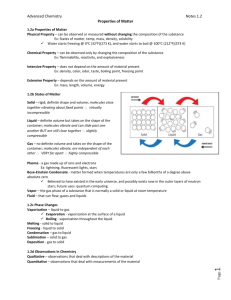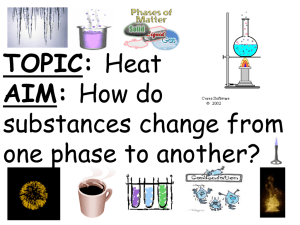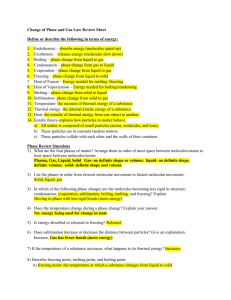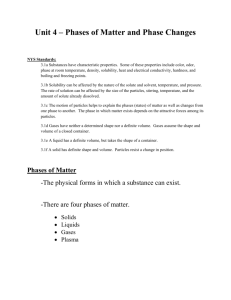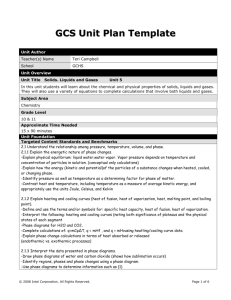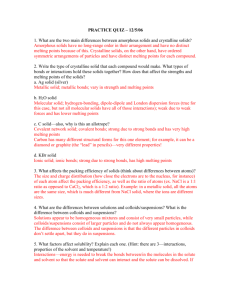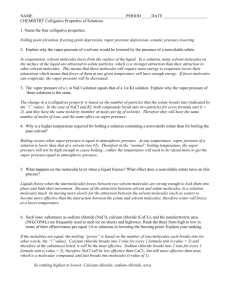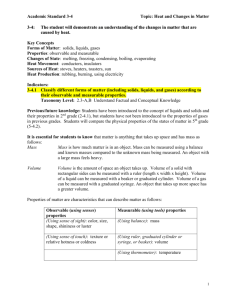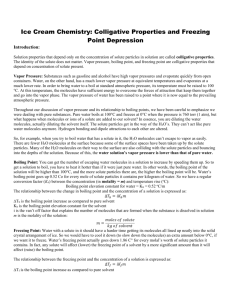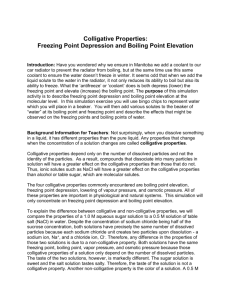2nd ASSESSMENT REVIEW SHEET_1st QUARTER-1
advertisement
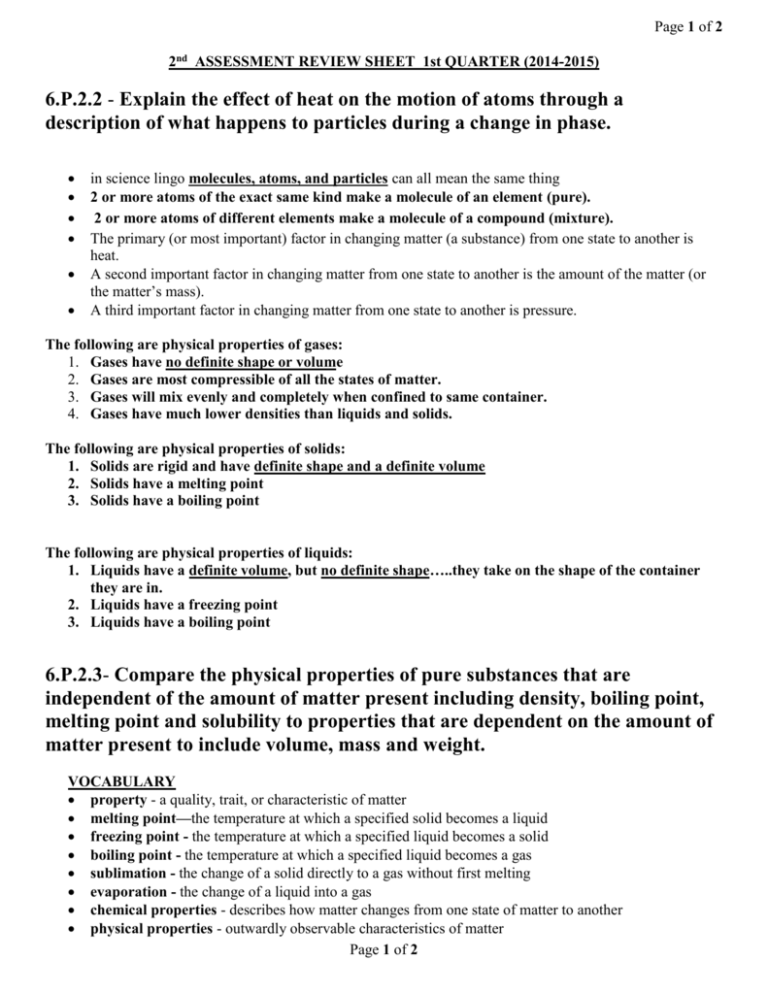
Page 1 of 2 2nd ASSESSMENT REVIEW SHEET_1st QUARTER (2014-2015) 6.P.2.2 - Explain the effect of heat on the motion of atoms through a description of what happens to particles during a change in phase. in science lingo molecules, atoms, and particles can all mean the same thing 2 or more atoms of the exact same kind make a molecule of an element (pure). 2 or more atoms of different elements make a molecule of a compound (mixture). The primary (or most important) factor in changing matter (a substance) from one state to another is heat. A second important factor in changing matter from one state to another is the amount of the matter (or the matter’s mass). A third important factor in changing matter from one state to another is pressure. The following are physical properties of gases: 1. Gases have no definite shape or volume 2. Gases are most compressible of all the states of matter. 3. Gases will mix evenly and completely when confined to same container. 4. Gases have much lower densities than liquids and solids. The following are physical properties of solids: 1. Solids are rigid and have definite shape and a definite volume 2. Solids have a melting point 3. Solids have a boiling point The following are physical properties of liquids: 1. Liquids have a definite volume, but no definite shape…..they take on the shape of the container they are in. 2. Liquids have a freezing point 3. Liquids have a boiling point 6.P.2.3- Compare the physical properties of pure substances that are independent of the amount of matter present including density, boiling point, melting point and solubility to properties that are dependent on the amount of matter present to include volume, mass and weight. VOCABULARY property - a quality, trait, or characteristic of matter melting point—the temperature at which a specified solid becomes a liquid freezing point - the temperature at which a specified liquid becomes a solid boiling point - the temperature at which a specified liquid becomes a gas sublimation - the change of a solid directly to a gas without first melting evaporation - the change of a liquid into a gas chemical properties - describes how matter changes from one state of matter to another physical properties - outwardly observable characteristics of matter Page 1 of 2 Page 2 of 2 mass - the amount of matter in a specific amount of matter weight – a measure of mass with the force of gravity acting on object volume - the amount of space matter takes up heat - the flow of energy from a warmer object to a cooler object; the energy generated by molecules speeding up temperature - a measure of the average amount of kinetic energy of the molecules in an object energy - the ability to do work or cause change solubility – the amount of solute that can be dissolved in a specific volume of solvent under certain conditions solute – the substance that is dissolved in a solution solvent – the substance that dissolves another substance into a solution dissolve – to make into a liquid; to liquefy density - the amount of mass per unit of volume the formula for density is mass divided by volume density = mass/volume d = m/v the melting point and the freezing point of an element are the same temperature the boiling point and condensation point of an element are the same temperature the melting point and freezing point of ice is 0° C (Celsius) the boiling point and condensation point of steam is 100°C (Celsius) the freezing point of water is also 0° C the boiling point of water is 100°C Know the difference between a solvent and a solute….for the examples that we have focused on in class, the solvent is the liquid and the solid is the solute….the solvent dissolves the solute……the solute is dissolved. Know the difference between physical and chemical properties. Wood burning into ashes in a chemical change just as metal that is rusting is a chemical change. Ice melting into water is a physical change. 6.P.3.1 - Illustrate the transfer of heat energy from warmer objects to cooler ones using examples of conduction, radiation and convection and the effects that may result. Anything that has molecules has heat Molecules in hot substances are moving fast; the faster the hotter Molecules in cold substances are moving slow; the slower the colder physical changes in matter take place when the energy is strong enough to overcome the attractive forces of the molecules….this contributes to expansion of matter when it is heated heat always moves from warmer to cooler objects heat is energy conduction—the transfer of energy by direct contact convection—when energy is transferred in gases and liquids by way of a warmer, less dense area of gas or liquid is pushed up by a cooler, more dense area of gas or liquid radiation—when energy is transferred by way of electromagnetic waves warm substances rise while cool substances sink Page 2 of 2


